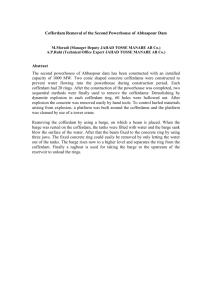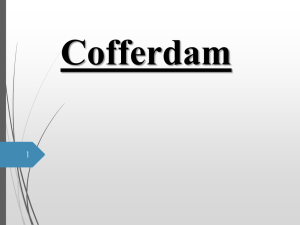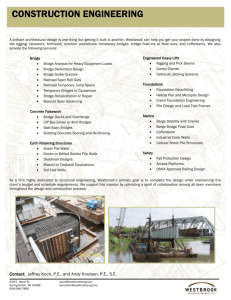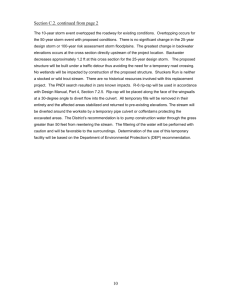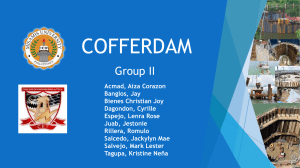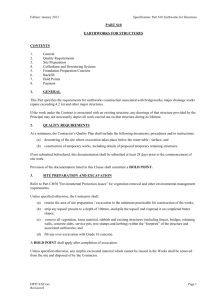SLAB FORM DESIGN I1
advertisement
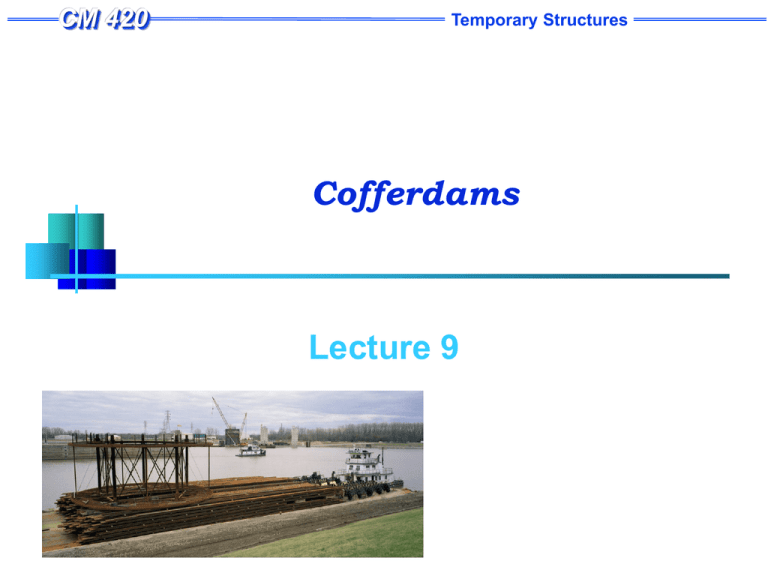
CM 420 Temporary Structures Cofferdams Lecture 9 CM 420 Temporary Structures Cofferdams “A cofferdam is a temporary structure designed to keep water and/or soil out of the excavation in which a bridge pier or other structure is built.” - Standard Handbook of Heavy Construction 1 CM 420 Temporary Structures Cofferdams Cofferdams are temporary enclosures to keep out water and soil so as to permit dewatering and construction of the permanent facility (structure) in the dry. A cofferdam involves the interaction of the structure, soil, and water. The loads imposed include the hydrostatic forces of the water, as well as the dynamic forces due to currents and waves. Because cofferdams are typically constructed under adverse conditions in a marine environment, and because significant deformations of elements may occur at various stages of construction, it is difficult to maintain close tolerances. Ample provisions must be made for deviations in dimensions so that the finished structure may be constructed according to plan. 2 CM 420 Temporary Structures Cofferdams The loads imposed on the cofferdam structure by construction equipment and operations must be considered, both during installation of the cofferdam and during construction of the structure itself. Removal of the cofferdam must be planned and executed with the same degree of care as its installation, on a stage-by-stage basis. The effect of the removal on the permanent structure must also be considered. For this reason, sheet piles extending below the permanent structure are often cut off and left in place, since their removal may damage the foundation soils adjacent to the structure. 3 CM 420 Temporary Structures Cofferdams In cofferdam construction, safety is a paramount concern, since workers will be exposed to the hazard of flooding and collapse. Safety requires: good design proper construction verification that the structure is being constructed as planned monitoring the behavior of the cofferdam and surrounding area provision of adequate access light and ventilation, and attention to safe practices on the part of all workers and supervisors. 4 CM 420 Temporary Structures Cofferdams Types of cofferdam: Braced Earth-Type Timber Crib Double-Walled Sheet Pile Cellular 5 CM 420 Temporary Structures Cofferdams Braced Cofferdams Formed from a single wall of sheet piling Driven into the ground to form a box around the excavation site The "box" is then braced on the inside Interior is dewatered Primarily used for bridge piers in shallow water (30 - 35 ft depth) 6 CM 420 Temporary Structures Cofferdams Cofferdam Design Considerations Scouring or undermining by rapidly flowing water Stability against overturning or tilting Upward forces on outside edge due to tilting Stability against vertical shear Effects of forces resulting from: Ice, Wave, Water, Active Earth and Passive Earth Pressures 7 CM 420 Temporary Structures Cofferdams Advantages of Cofferdam Allow excavation and construction of structures in otherwise poor environment Provides safe environment to work Contractors typically have design responsibility Steel sheet piles are easily installed and removed Materials can typically be reused on other projects 8 CM 420 Temporary Structures Cofferdams Items needed for installation Pile driving hammer Vibratory or Impact Crane of sufficient size Steel sheet piles are typically used H-piles and/or wide-flange beams for wales and stringers Barges may be required 9 CM 420 Temporary Structures Cofferdams TYPES OF IMPOSED LOADS Hydrostatic pressure The maximum probable height outside the cofferdam during construction and the water height inside the cofferdam during various stages of construction need to be considered. These result in the net design pressure shown below: Hydrostatic forces on partially dewatered cofferdam 10 CM 420 Temporary Structures Cofferdams TYPES OF IMPOSED LOADS Forces due to Soil Loads The soils impose forces, both locally on the wall of the cofferdam and globally upon the structure as a whole. These forces are additive to the hydrostatic forces. Local forces are a major component of the lateral force on sheet-pile walls, causing bending in the sheets, bending in the wales, and axial compression in the struts 11 CM 420 Temporary Structures Cofferdams TYPES OF IMPOSED LOADS Forces due to Soil Loads (Cont’d) 12 CM 420 Temporary Structures Cofferdams TYPES OF IMPOSED LOADS Current Forces on Structure With a typical cofferdam, the current force consists not only the force acting on the normal projection of the cofferdam but also on the drag force acting along the sides. With flat sheet piles, the latter may be relatively small, whereas with z-piles it may be substantial, since the current will be forming eddies behind each indentation of profile, as shown below. 13 CM 420 Temporary Structures Cofferdams TYPES OF IMPOSED LOADS Wave forces Waves acting on a cofferdam are usually the result of local winds acting over a restricted fetch and hence are of short wavelength and limited to height. Waves can also be produced by passing boats and ships, especially in a restricted waterway. 14 CM 420 Temporary Structures Cofferdams TYPES OF IMPOSED LOADS Ice forces These are of two types: the force exerted by the expansion of a closedin solidly frozen-over area of water surface (static ice force) and the forces exerted by the moving ice on breakup (dynamic ice force). As an example, for static ice force, a value of 4000 lb/ft2 has been used on cofferdams and structures on the great Lakes, whereas the value due to dynamic ice force on a cofferdam-type structure are often taken at 12,000 to 14,000 lb/ft2 of contact area. 15 CM 420 Temporary Structures Cofferdams TYPES OF IMPOSED LOADS Seismic Loads These have not been normally considered in design of temporary structures in the past. For very large, important, and deep cofferdams in highly seismically active areas, seismic evaluation should be performed. Accidental loads These are the loads usually caused by construction equipment working alongside the cofferdam and impacting on it under the action of waves. 16 CM 420 Temporary Structures Cofferdams Scour Scour of the river bottom or seafloor along the cofferdam may take place owing to river currents, tidal currents, or wave-induced currents. Some of the most serious and disastrous cases have occurred when these currents have acted concurrently. A very practical method of preventing scour is to deposit a blanket of crushed rock or heavy gravel around the cofferdam, either before or immediately after the cofferdam sheet piles are set. A more sophisticated method is to lay a mattress of filter fabric, covering it with rock to hold it in place. 17 CM 420 Temporary Structures Cofferdams Cofferdam Components Sheet piling Bracing frame Concrete seal Bearing piles 18 CM 420 Temporary Structures Cofferdams The typical cofferdam, such as a bridge pier, consists of sheet piles set around a bracing frame and driven into the soil sufficiently far to develop vertical and lateral support and to cut off the flow of soil and, in some cases the flow of water. 19 CM 420 Temporary Structures Cofferdams The structure inside may be founded directly on rock or firm soil or may require pile foundations. In the latter case, these generally extend well below the cofferdam. In order to dewater the cofferdam, the bottom must be stable and able to resist hydrostatic uplift. Placement of an underwater concrete seal course is the fastest and most common method. 20 CM 420 Temporary Structures Cofferdams An underwater concrete seal course may then be placed prior to dewatering in order to seal off the water, resist its pressure, and also to act as a slab to brace against the inward movement of the sheet piles in order to mobilize their resistance to uplift under the hydrostatic pressure. 21 CM 420 Temporary Structures Cofferdams Construction Sequence For a typical cofferdam, such as for a bridge pier, the construction procedure follow the listed pattern. 1. Pre-dredge to remove soil or soft sediments and level the area of the cofferdam. 22 CM 420 Temporary Structures Cofferdams Construction Sequence 2. Drive temporary support piles 3. Temporarily erect bracing frame on the support piles. 23 CM 420 Temporary Structures Cofferdams Construction Sequence 4. Set steel sheet piles, starting at all four corners and meeting at the center of each side 5. Drive sheet piles to grade. 6. Block between bracing frame and sheets, and provide ties for sheet piles at the top as necessary. 24 CM 420 Temporary Structures Cofferdams Construction Sequence 7. Excavate inside the grade or slightly below grade, while leaving the cofferdam full of water. 25 CM 420 Temporary Structures Cofferdams Construction Sequence 8. Drive bearing piles. 9. Place rock fill as a leveling and support course. 26 CM 420 Temporary Structures Cofferdams Construction Sequence 10. Place tremie concrete seal. 27 CM 420 Temporary Structures Cofferdams Construction Sequence Tremie concrete seal. 28 CM 420 Temporary Structures Cofferdams Construction Sequence Tremie concrete seal. 29 CM 420 Temporary Structures Cofferdams Construction Sequence 11. Check blocking between bracing and sheets. 12. Dewater. 13. Construct new structure. 30 CM 420 Temporary Structures Cofferdams Cofferdam for the Sidney Lanier Bridge, Oregon 31 CM 420 Temporary Structures Cofferdams Construction Sequence 13. Construct new structure. 14. Flood cofferdam. 32 CM 420 Temporary Structures Cofferdams Construction Sequence 15. Remove sheet piles. 16. Remove bracing. 17. Backfill. 33 CM 420 Temporary Structures Cofferdams Traditional Sheet Pile Shapes Z-Type (Z) Used for intermediate to deep wall construction Larson / “U” Type (U) Used for applications similar to Z - Type Flat / Straight Type (SA), (S) Used for filled cell construction Arch shaped & lightweight Used for shallower wall construction 34 CM 420 Temporary Structures Cofferdams Typical types of interlocks Ball & Socket (BS) Single Jaw (SJ) Double Jaw (DJ) Hook & Grip (HG) Thumb & Finger one point contact (TFX) Double Hook (DH) Thumb & Finger three point contact (TF) 35 CM 420 Temporary Structures Cofferdams Braced Cofferdam Construction Install Wale and Strut System for Framework /Template 36 CM 420 Temporary Structures Cofferdams Braced Cofferdam Construction Install Wale and Strut System for Framework /Template (Cont’d) 37 CM 420 Temporary Structures Cofferdams Tips for installing Sheet piles: Always set-up a template system Rule of thumb: Crane Boom length should be twice that of the sheets Drive the Sheets with the "male" interlock leading in order to avoid soil plugs If the "female" interlock must lead, place a bolt or other object at the bottom to avoid debris filling the slot Align and plumb the first two sheets and drive carefully and accurately Drive sheets in pairs when possible placing the hammer in the center of the pair 38 CM 420 Temporary Structures Cofferdams Tips for installing Sheet piles (Cont’d): Some contractors recommend not driving a sheet more than 1/3 its length before driving the adjacent pile Letting the sheets "freefall" and drop in order to aid in penetration will generally cause the sheets to fall "out of plumb" Cellular cofferdams require that all sheets are set and "closed" before any driving is done Finally… never rush the Pile Foreman!! 39
